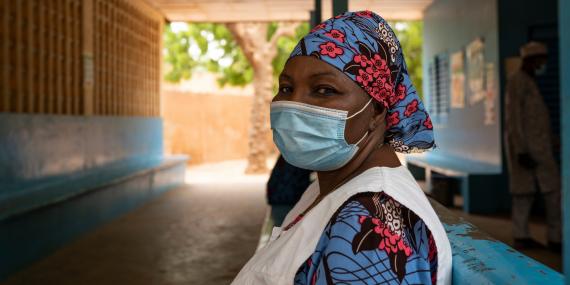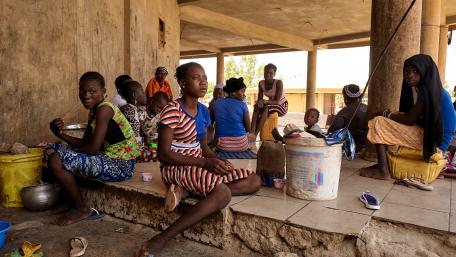Niamey, Niger
This nurse works at the Gamkalé health centre in Niamey, Niger. “With the arrival of the first cases of COVID-19 in Niamey, the mothers were afraid to come to the health centre,” she says. “We noticed a drop in visits and it was very worrying because we know how much mothers and children need the routine services of the centre." Her colleague, the head of the centre's immunization unit, says: "We cannot turn our backs on other diseases such as polio or measles as their impact may be greater than COVID-19. With a lot of effort in raising awareness within the communities, mothers are starting to feel more comfortable with visiting the centre again, but the rhythm of visits is still slow compared to normal times. We are working hard to ensure the children continue to be vaccinated.” UNICEF/Juan Haro
The Global Humanitarian Overview 2020 presented initial funding requirements of $29 billion to assist 109 million of the 168 million people in need. By April, requirements had reached $31 billion following the finalization of several response plans in the first quarter of the year and the addition of the Global Humanitarian Response Plan (GHRP) for COVID-19 in March.
By mid-November, following two updates of the GHRP and adjustments made to response plans in the context of COVID-19, requirements had reached $39 billion to assist 265 million of the 441 million people in need in 64 countries. Until the July GHRP update, funding levels – both relative and absolute – were on par with previous years. Despite high levels of contributions this year, the gap between requirements and funding is larger than ever: $22 billion. This was approximately the total amount of global humanitarian requirements three years ago. Funding for the GHRP has reached $3.8 billion, or 40 per cent of the $9.5 billion required.
Total Humanitarian Funding (2012-2020)
Some of the 2020 funding was repurposed to quickly adapt the existing response, provide protective equipment for humanitarian workers and people receiving aid, and scale up response to some of the secondary socioeconomic impacts of the pandemic in humanitarian contexts. Renewed emphasis was placed on prioritizing vulnerable groups, and providing funding to NGOs, frontline responders and anticipatory action initiatives. Inter-agency guidance was issued to encourage more harmonized and flexible approaches to cascading funding.
Inter-Agency Coordinated Appeals: Results from 2020
Despite the impact of the pandemic on donor economies, additional funding was secured in several cases; significant flexible funding was provided for the rapidly evolving situation; disbursements planned for later in the year were advanced. Some good funding practices have emerged, but humanitarian organizations, particularly NGOs and local responders, are suffering from severe underfunding and have been unable to carry out many activities planned for 2020.
Funding gap (2012-2020)
Renewed emphasis was placed on the importance of prioritizing vulnerable groups; providing funding to NGOs, front-line responders, and anticipatory action initiatives; and inter-agency guidance was issued to encourage more harmonized and flexible approaches to cascading funding. While some good funding practices have emerged, humanitarian organizations – and particularly NGOs and local responders – are suffering from severe underfunding. Some have had to rely on internal reserves and re-programming of existing funds to continue providing aid, while many have been unable to carry out planned activities for 2020.
Evolution of HRP requirements (2020)
High-Level Pledging Events coordinated by OCHA
Donors at the High-Level Roundtable for Sudan (January), held in London, committed to providing funding effectively, including through multi-year and flexible support. At the virtual High-Level Pledging Event for Yemen (June), donors announced $1.35 billion to meet the needs of conflict-affected people. As of mid-November, 85 per cent of pledges had been committed. At the virtual Supporting the Future of Syria and the Region event (June), significant pledges for humanitarian, development and stabilization activities were made, totaling $5.5 billion for 2020 and $2.2 billion for 2021 and beyond. Nearly all the funding pledged for 2020 has been committed. Ninety per cent of pledges made at the Ending Sexual and Gender-based Violence in Humanitarian Crises event, held in Oslo in 2019, have been fulfilled. Donors at the virtual Ministerial Roundtable for Central Sahel (October) announced $1.74 billion for 2020 and beyond to scale up life-saving humanitarian aid to millions of people in Burkina Faso, Mali and Niger.
Further reading
Source: Financial Tracking Service
Source: Humanitarian Insight
Source: OCHA
References
- Sixty-three countries were covered under the GHRP and Honduras issued a new Flash Appeal in November 2020.





